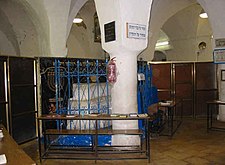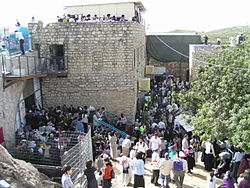Shimon bar Yochai

Simeon bar Yochai (Aramaic: רבן שמעון בר יוחאי, Rabban Shimon bar Yochai), also known by his acronym Rashbi,[1] was a 2nd-century tannaitic sage in ancient Israel, said to be active after the destruction of the Second Temple in 70 CE. He was one of the most eminent disciples of Rabbi Akiva, and is pseudepigraphically attributed by many Orthodox Jews with the authorship of the Zohar, the chief work of Kabbalah.
In addition, important legal homilies called Sifre and Mekhilta are attributed to him (not to be confused with the Mekhilta of Rabbi Ishmael, of which much of the text is the same). In the Mishnah, in which he is the fourth-most mentioned sage, he is often referred to as simply "Rabbi Shimon".[2]
According to popular legend, he and his son, Eleazar b. Simeon, were noted Kabbalists.[3] Both figures are held in unique reverence by kabbalistic tradition. They were buried in the same tomb in Meron, Israel, which is visited by thousands year round.
Critic of Rome

According to a legend in the Babylonian Talmud, Rabbi Shimon bar Yohai criticized the Roman government and was forced to go into hiding with his son for thirteen years. They sheltered in a cave (which local tradition places in Peki'in). Next to the mouth of the cave a carob tree sprang up and a spring of fresh water gushed forth. Provided against hunger and thirst they cast off their clothing except during prayers to keep them from wearing out, embedded themselves in the sand up to their necks, and studied the Torah all day long. He and his son left the cave when they received a bat qol (divine revelation) saying that the Roman emperor had died and consequently all his decrees were abolished.[4]
Works and legends
According to rabbinic sources, he acquired a reputation as a worker of miracles, and on this ground was sent to Rome as an envoy, where, according to legend, he exorcised from the emperor's daughter a demon who had obligingly entered the lady to enable Rabbi Shimon to effect his miracle.
His legal decisions also carried much weight in rabbinic literature.[citation needed]
The fullest account of Rabbi Shimon's teachings is to be found in W Bacher's Agada der Tannaiten, ii. pp. 70–149. When the Talmud attributes a teaching to Rabbi Shimon without specifying which Rabbi Shimon is meant, it means Shimon bar Yochai.
There is a mid-eighth-century Jewish apocalypse attributed to the Rabbi; see The Secrets of Rabbi Simon ben Yohai.
While he is attributed authorship of the Zohar by many kabbalists, the authenticity of this claim has been challenged by both secular[5] and religious scholars.[6][7] who point to Moses de León as the author who published the Zohar in the 13th century.
Yahrzeit

Bar Yochai died on the 33rd day of the Omer, known as Lag BaOmer. On the day of his death, he revealed deep kabbalistic secrets which formed the basis of the Zohar. According to the Bnei Yissaschar, on the day of his death, bar Yochai said, "Now it is my desire to reveal secrets... The day will not go to its place like any other, for this entire day stands within my domain..." Daylight was miraculously extended until he had completed his final teaching and died. As such, the custom of lighting fires on his yahrzeit (anniversary of death) symbolizes this revelation of powerful light.[citation needed]
His yahrzeit is widely known as a Yom Hillula, a day of celebration. This is based on the original text of Shaar HaKavanot by Rabbi Chaim Vital, which refers to the day as Yom Simchato ("the day of his happiness"), rather than Yom SheMet ("the day that he died"). There is thus a very widely observed custom to celebrate on his yahrzeit at his burial place in Meron. With bonfires, torches, song and feasting, the Yom Hillula is celebrated by hundreds of thousands of people. This celebration was a specific request by Rabbi Shimon bar Yochai of his students. Some say that as bar Yochai gave spiritual light to the world with the revelation of the Zohar, bonfires are lit to symbolize the impact of his teachings. As his passing left such a "light" behind, many candles and/or bonfires are lit here as well as in locales throughout Israel and the Diaspora.[8]
Yahrzeit customs at the tomb
Bonfires
At the tomb of Rabbi Shimon, the honour of lighting the main bonfire traditionally goes to the Rebbes of the Boyaner dynasty. This privilege was purchased by Rabbi Avrohom Yaakov Friedman, the first Sadigura Rebbe, from the Sephardi guardians of Meron and Safed. The Sadigura Rebbe bequeathed this honor to his eldest son, Rabbi Yitzchok Friedman, the first Boyaner Rebbe, and his progeny.[9] The first hadlakah (lighting) is attended by hundreds of thousands of people annually; in 2001, the crowd was estimated at 300,000.[10]
First haircut for boys
It is customary at the Meron celebrations, dating from the time of Rabbi Isaac Luria, that three-year-old boys be given their first haircuts (upsherin), while their parents distribute wine and sweets.[11]
Chai rotel
Another custom at the tomb of Rabbi Shimon bar Yochai is the giving of chai rotel (Template:Lang-he). The Hebrew letters chet and yod are the gematria (numerical equivalent) of 18. Rotel is a liquid measure of about 3 litres. Thus, 18 rotels equals 54 litres or about 13 gallons. It is popularly believed that if one donates or offers 18 rotels of liquid refreshment (grape juice, wine, soda or even water) to those attending the celebrations at bar Yochai's tomb on Lag BaOmer, then the giver will be granted miraculous salvation.[12]
According to Taamei Minhagim, many childless couples found success with this segula (propitious practice). This practice was also endorsed by Rabbi Ovadia miBartenura[13] and The Shelah HaKadosh.[14] The Bobover Rav, The Kedushas Tzion sent a letter from Poland to his Chassidim in Israel asking them to donate chai rotel in Meron on this holy day on behalf of a couple that did not have children.[14] Several local organizations solicit donations of chai rotel and hand out the drinks on the donor's behalf in Meron on Lag BaOmer. Nine months after Lag BaOmer, the Ohel Rashbi organization even invites couples who prayed at the tomb and had a child to come back to Meron to celebrate the births.[13]
Controversies
Because of the extreme persecution of the Jews during the time of bar Yochai, some of his views were very hostile towards gentiles. The Jewish Encyclopedia of 1906 describes him as the preeminent anti-gentile teacher.[15]
Simeon bar Yochai is often quoted by antisemites in his saying "Best of gentiles kill it, best of snakes cut its head, the most pious of women is prone to sorcery."[16] This hostility to Romans is repeated in one of his maxims: "If you see a Persian horse tied in Israel, then hope for the arrival of the Messiah."[17] Because of the extreme animosity in Bar Yochai's quote, some later versions of his writings were altered to replace "the best of gentiles" with "the best of Egyptians".[18]
See also
- Baqashot
- Bar Yochai (song)
- Bar Yohai, a community in northern Israel named after him
- Eleazar b. Simeon (his son)
References
- ^ Rabbi Shimeon bar Yochai.
- ^ Drew Kaplan, "Rabbinic Popularity in the Mishnah VII: Top Ten Overall [Final Tally] Drew Kaplan's Blog (5 July 2011).
- ^ The Rav Shabtai Ben Yaakov Yitzhak Lifshitz, Segulot Israel (The Virtue of Israel), Set no. 7, Item 5
- ^ Babylonian Talmud, Shabbat, 33b.
- ^ Rubin, Ephraim. "When Was the Zohar Written?". http://www.talkreason.org.
{{cite web}}: External link in|publisher= - ^ Rabbi David Bar-Hayim. "Truth, Authenticity, Tradition and Reason: Who Wrote the Zohar?". Machon Shilo.
- ^ Rabbi Yiḥyah Qafiḥ. "The Holy Wars Against the False Qabalah of the Zohar". chayas.com.
- ^ Silberberg, Naftali (2011). "Lag BaOmer Traditions and Customs". chabad.org. Retrieved 5 December 2011.
- ^ Rossoff, Dovid (2005). קדושים אשר בארץ: קברי צדיקים בירושלים ובני ברק (in Hebrew). Jerusalem: Machon Otzar HaTorah. pp. 315–316.
{{cite book}}: Unknown parameter|trans_title=ignored (|trans-title=suggested) (help) - ^ Brayer, Rabbi Menachem (2003). The House of Rizhin: Chassidus and the Rizhiner Dynasty. Mesorah Publications. p. 435. ISBN 1-57819-794-5.
- ^ Rossoff, Dovid. "Meron on Lag B'Omer". The Jewish Magazine. Retrieved 2010-04-28.
- ^ Lebovits, Moishe Dovid. "Lag BaOmer". Halachically Speaking. p. 6. Retrieved 27 April 2010.
- ^ a b "Over 500,000 Expected in Meron for Lag Ba'omer, 5769". matzav.com. 2009-05-11. Retrieved 2010-04-28.
- ^ a b "Chai Rotel Segulah". YeshuosRashbi.com. Retrieved 14 April 2013.
- ^ http://www.jewishencyclopedia.com/articles/6585-gentile
- ^ http://www.jewishencyclopedia.com/articles/13723-simeon-ben-yohai
- ^ http://www.sefaria.org/Shir_HaShirim_Rabbah.8.9
- ^ http://www.jewishencyclopedia.com/articles/6585-gentile
External links
This article's use of external links may not follow Wikipedia's policies or guidelines. (September 2015) |
- Rabbi Shimon Bar Yochai chabad.org
- Audio Lecture Disputing that Lag Ba'Omer is Rashbi's Yahrzeit on MachonShilo.org
- SIMEON BEN YOḤAI in the Jewish Encyclopedia
